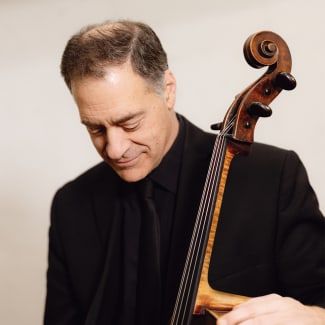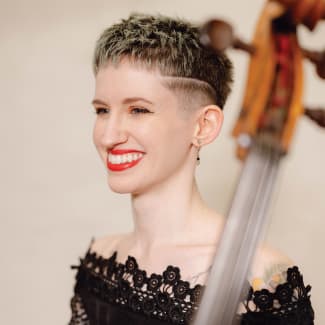Cello
String Family
You’ll notice right away that the cello is much larger than the violin and viola. In fact, it’s so large that you have to sit down to play it! The cello has quite a wide pitch range, from warm, low notes to rich, high notes. The body of the cello sits between your knees, and the neck of the cello goes in front of your left shoulder. Your left hand presses down on the strings to change the pitch, and your right hand moves the bow or plucks the strings. The cello touches the ground, supported by a metal peg called the endpin. The cello has four strings tuned a fifth apart, and from highest to lowest, they are: A, D, G, and C. The string names may be the same as the viola, but they sound one octave lower.
Artists

Dynamic leader of the Minnesota Orchestra’s cello section since 1991, prize-winning cellist Anthony Ross has appeared as soloist many times with the Orchestra, performing all the standard cello concertos under Osmo Vänskä, Edo de Waart and Eiji Oue. Equally passionate about new music, he has given powerful performances of Michael Daugherty’s Tales of Hemingway, James MacMillan’s Cello Concerto, Paul Moravec’s Montserrat, and he and his wife, cellist Beth Rapier, have championed David Ott’s Concerto for Two Cellos since 1993. Prior to assuming the principal role in Minnesota, Ross performed for four years as principal cello of the Rochester Philharmonic under David Zinman.
Ross’ compelling interpretations have won wide acclaim from Moscow to Kalamazoo, and Dallas to Duluth. As concerto soloist, he has played with the Moscow State Orchestra, the Louisville Orchestra, the Dallas Symphony, the Rochester Philharmonic, the South Dakota Symphony and many other Midwest regional orchestras. Ross’ recordings include Leonard Bernstein’s Three Meditations from Mass, the George Lloyd Cello Concerto with the Albany Symphony, and the sonatas of Rachmaninoff and Elliott Carter.

Silver Ainomäe was born in Tallinn, Estonia. At the age of six he began to play the cello and piano. In 1990 Silver's family migrated from Estonia to Finland and at the age of twelve, he was accepted to the Sibelius Academy in Helsinki, where his teachers were Hannu Kiiski and Arto Noras. After receiving a master’s degree at the Sibelius Academy, he attended London's Guildhall School of Music and Drama and Razumovsky Academy under the guidance of Oleg Kogan. He has been awarded multiple prizes and awards at competitions worldwide including the Isang Yun, Lutoslawski and Paulo competitions.

Beth Rapier joined the Minnesota Orchestra in 1986 and served as assistant principal cello from 1991 until 2022, when she chose to move into the core of the cello section. She has been a featured soloist with the Orchestra in works by Haydn, David Ott and Kevin Puts, the latter being the world premiere of his Sinfonia Concertante in 2006. Throughout her tenure with the Orchestra she has performed regularly at its Sommerfest, MacPhail and Target Atrium Chamber Music concerts.
An accomplished chamber musician, Rapier won top awards at several competitions in the U.S. and Canada and has performed quartets throughout Europe, Asia and the U.S. She is a regular guest at chamber music festivals, including Cactus Pear, Music in the Vineyards, Bach Dancing and Dynamite Society, and Orcas Island. Other appearances include the Rockport Chamber Music Festival, Mainly Mozart (San Diego), Pensacola Chamber Music Festival, Barge Music (New York City), Bing Series (Los Angeles), Festival Mozart (Lille, France), and the Santa Barbara and MET Museum Chamber Music Series.

Katja Linfield, who joined the Minnesota Orchestra in 1990, has been an active chamber musician and proponent of contemporary and lesser-known works. In previous seasons, she performed Tan Dun’s Elegy: Snow in June for solo cello and four percussionists, John Mackey’s bluegrass string trio Wrong-Mountain Stomp and Judd Greenstein’s string quartet Four on the Floor. She has also performed works of Dvořák, Hindemith, Brahms, Golijov, Walton and Sundström.
Linfield was a member of the Bakken Trio from 1992 until 2002, a period during which the ensemble recorded works of Ives, Pärt and Beethoven. She has twice received the McKnight Fellowship for Performing Musicians, in 2006 as soloist and in 2001 with the Bakken Trio.

Illinois native Sonia Mantell joined the Minnesota Orchestra cello section in September 2020. She studied at New England Conservatory and DePaul School of Music under the tutelage of Natasha Brofksy and Brant Taylor, respectively. She was appointed co-principal cellist of the NEC orchestras and the Civic Orchestra of Chicago. While attending DePaul, she won the Concerto Competition with violinist Ari Urban and performed the Brahms Double Concerto with the DePaul Symphony. She has attended summer festivals at Aspen, National Orchestral Institute, Music Academy of the West and Tanglewood Music Center.

Cellist Pitnarry Shin has toured throughout the United States, Europe and her native Korea. She has performed as soloist with the Korean Broadcasting System (KBS) Symphony Orchestra, the Kunsan Philharmonic, the Yale Symphony Orchestra, the Springfield Symphony Orchestra and the Queens Symphony Orchestra. She has also appeared at many of the leading international festivals including the Ravinia Festival, the Edinburgh and Dartington Festivals (England), Colmar and Evian Festivals (France), Banff Festival (Canada) and the Piatigorsky Seminar. She was the recipient of a Fulbright Grant to Germany, which allowed her to participate and perform in several European festivals such as the Manchester Festival, the Kronberg Festival and the Ensemble InterContemporain Summer Festival, where she played solo cello under Pierre Boulez.
Shin was a member of the Minnesota Orchestra from 2001 to 2006 and returned as a full time member again in 2012. In addition to her orchestral work, she serves as an artistic director of the Bakken Trio.

Cellist Arek Tesarczyk joined the Minnesota Orchestra in 2004 and made his solo in 2006, performing Beethoven’s Triple Concerto. He gave the world premiere performances of Rautavaara’s Cello Concerto No. 2, Towards the Horizon, under the baton of Osmo Vänskä in fall 2010. He has presented a full range of concerto repertoire, including works by Dvořák, Elgar, Saint-Saëns, Haydn, Schumann, Tchaikovsky and Goldschmidt, as soloist with the Winnipeg Symphony Orchestra, Silesian Chamber Orchestra, Orchesta Sinfonica de Chile and Concert Artists of Baltimore.

Houston-born cellist Erik Wheeler began his musical studies with Diane Bonds at the age of five, and subsequently studied with Steve Laven, Lynn Harrell and Brinton Smith. He earned his undergraduate degree from Rice University, where his principal teacher was Desmond Hoebig, after which he spent a year at the Juilliard School with Richard Aaron. While at Rice, he performed Tchaikovsky’s Rococo Variations with the Shepherd School Chamber Orchestra as the winner of the school’s concerto competition, and served as principal cellist for the Shepherd School Symphony Orchestra.
